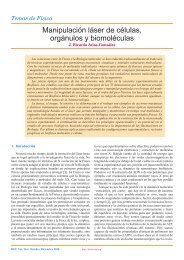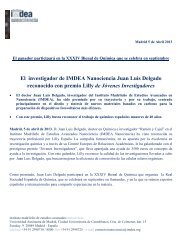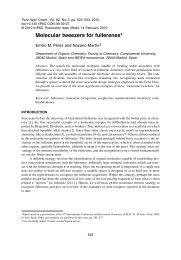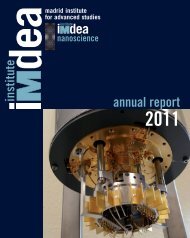Energy, supramolecular chemistry, fullerenes, and the sky* - IMDEA ...
Energy, supramolecular chemistry, fullerenes, and the sky* - IMDEA ...
Energy, supramolecular chemistry, fullerenes, and the sky* - IMDEA ...
- No tags were found...
Create successful ePaper yourself
Turn your PDF publications into a flip-book with our unique Google optimized e-Paper software.
<strong>Energy</strong>, <strong>chemistry</strong>, <strong>fullerenes</strong>, <strong>and</strong> organic solar cells 203important implications when it comes to <strong>the</strong> possible noncovalent interactions that we can utilize toassociate <strong>fullerenes</strong> in solution. The impossibility of utilizing strong directional forces, like metal–lig<strong>and</strong>coordination or hydrogen bonding, to recognize <strong>fullerenes</strong>, leaves us with π–π, van der Waals, <strong>and</strong>solvophobic interactions as key factors to consider. Fortunately, optimizing all of <strong>the</strong>m requires <strong>the</strong>same strategy: increasing <strong>the</strong> surface of <strong>the</strong> receptor in short contact with <strong>the</strong> fullerene guest. Thus, <strong>the</strong>nuts <strong>and</strong> bolts of <strong>the</strong> design of hosts for <strong>fullerenes</strong> is <strong>the</strong> construction of a nonpolar cavity—preferentiallybut not necessarily featuring aromatic recognizing units—of <strong>the</strong> appropriate size to fit <strong>the</strong>fullerene guest.The search for molecules capable of associating <strong>fullerenes</strong> in solution was initiated just sevenyears after <strong>the</strong> discovery of C 60 <strong>and</strong> immediately after it became available in sufficient quantities bycontact-arc vaporization of graphite [12]. In 1992, <strong>the</strong> first designed host for <strong>fullerenes</strong> was reported byDiederich, Ringsdorf, <strong>and</strong> co-workers [13]. The receptor was based on a macrocyclic azacrown e<strong>the</strong>r inwhich <strong>the</strong> nitrogen groups were alkylated or acylated with aromatic groups, fur<strong>the</strong>r substituted withlong alkane chains, forming a lipophilic “cup”. Through a combination of surface pressure-area diagrams,UV–vis spectroscopy, <strong>and</strong> atomic force microscopy (AFM), <strong>the</strong> authors showed that <strong>the</strong><strong>fullerenes</strong> preferentially dwelled inside <strong>the</strong> lipophilic cavities.In <strong>the</strong> same year, Wennerström’s group described <strong>the</strong> encapsulation of C 60 by two units ofγ-cyclodextrin to obtain water-soluble complexes [14], extending <strong>the</strong> same concept to C 70 two yearslater [15]. The positive cyclodextrin–fullerene interaction, particularly in water, has been exploited tobuild organized fullerene nanostructures [16–20]. At approximately <strong>the</strong> same time, <strong>the</strong> groups of Raston<strong>and</strong> Shinkai, working independently, reported <strong>the</strong> selective purification of C 60 from fullerene soot byits selective association with p-tert-butylcalix[8]arene [21,22]. Drawing from <strong>the</strong>se seminal investigations,several receptors based on calixarenes—mainly calix[5]arenes—have been described [23–34].Cyclotriveratrylenes (CTVs) have also been extensively investigated for <strong>the</strong> molecular recognitionof <strong>fullerenes</strong>. CTV was first found to interact with C 60 forming 1:1 complexes in <strong>the</strong> solid state[35]. Later, mainly by extension of <strong>the</strong> cavity of CTV or by <strong>the</strong> construction of dimeric capsules, a richcollection of hosts that work in solution <strong>and</strong> on surfaces have been conceived <strong>and</strong> syn<strong>the</strong>sized [36–44].Porphyrins are well known to interact favorably with <strong>fullerenes</strong> both in solution <strong>and</strong> in <strong>the</strong> solidstate, which has been thoroughly exploited in <strong>the</strong> design of receptors for <strong>fullerenes</strong> [45,46]. In <strong>the</strong> para -digmatic example, Aida reported <strong>the</strong> formation of very stable inclusion complexes between <strong>fullerenes</strong><strong>and</strong> a dimeric construct in which two metalloporphyrins are linked by flexible alkyl spacers, forming amacrocycle [47]. Structural variations on this design have led to what is probably <strong>the</strong> richest collectionof receptors for <strong>fullerenes</strong> [48], including <strong>the</strong> world-record holder in complex stability, with log K a =8.1 in 1,2-dichlorobenzene at room temperature [49], <strong>and</strong> <strong>the</strong> first chiral sensors for <strong>the</strong> inherently chiralhigher <strong>fullerenes</strong> [50,51]. Besides Aida’s work on macrocyclic structures, several molecular tweezersfeaturing porphyrins as binding motifs have also been reported [52,53], spearheaded by <strong>the</strong> work byBoyd <strong>and</strong> Reed on <strong>the</strong>ir “jaws” receptors [54–56]. More recently, concave recognition motifs [57,58],complementary to <strong>the</strong> convex surface of <strong>the</strong> <strong>fullerenes</strong>, like corannulene [59–61], or cyclo -phenyleneacetylenes, have been explored [62–65].© 2010, IUPAC Pure Appl. Chem., Vol. 83, No. 1, pp. 201–211, 2011







